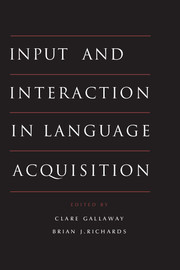Book contents
- Frontmatter
- Contents
- List of figures
- List of tables
- List of contributors
- Preface
- Introduction
- Part I General issues
- Part II Specific aspects of input and interaction
- Part III Types of language learner
- 8 Language interaction with atypical language learners
- 9 Interaction and childhood deafness
- 10 Input and interaction in second language acquisition
- Conclusion
- References
- Author index
- Subject index
10 - Input and interaction in second language acquisition
Published online by Cambridge University Press: 05 June 2012
- Frontmatter
- Contents
- List of figures
- List of tables
- List of contributors
- Preface
- Introduction
- Part I General issues
- Part II Specific aspects of input and interaction
- Part III Types of language learner
- 8 Language interaction with atypical language learners
- 9 Interaction and childhood deafness
- 10 Input and interaction in second language acquisition
- Conclusion
- References
- Author index
- Subject index
Summary
Introduction
The nature of the linguistic environment available to learners of a second/foreign language and its role in the learning process have been important issues for second language acquisition (SLA) researchers and language educators over the past two decades. Inspired by work in first language acquisition suggesting that oral language input tuned to the language development level of learners might play a causal role in language acquisition (see Richards and Gallaway 1993) and the early second language research on “foreigner talk” (Clyne 1968, 1977, 1978; Ferguson 1971, 1975), a few SLA researchers began to investigate these issues in classroom situations – notably Henzl (1973, 1979), Hatch (1974, 1978a, 1978b) and her students (Wagner-Gough and Hatch 1975; Long 1981a), and in natural communicative settings (the Heidelberger Forschungs projekt 1975; Meisel 1975). Of particular interest have been the modifications to language and, more recently, to conversational interaction patterns made by native speakers when addressing less proficient nonnative speakers – both in and out of classrooms. Several hundred studies now exist which document the nature of these modifications, the conditions under which they occur, and their possible purposes, and recent research has attempted to link learning contexts and input/interaction features with SLA outcomes.
Research on the linguistic environment of the language learner has in the main followed a “research-then-theory” strategy (Long 1985). Initially cross-sectional and quantitative in approach, yielding descriptions and taxonomies, research now includes longitudinal case studies and classroom ethnography, as well as quasi-experimental and experimental studies.
Information
- Type
- Chapter
- Information
- Input and Interaction in Language Acquisition , pp. 219 - 250Publisher: Cambridge University PressPrint publication year: 1994
Accessibility standard: Unknown
Why this information is here
This section outlines the accessibility features of this content - including support for screen readers, full keyboard navigation and high-contrast display options. This may not be relevant for you.Accessibility Information
- 21
- Cited by
